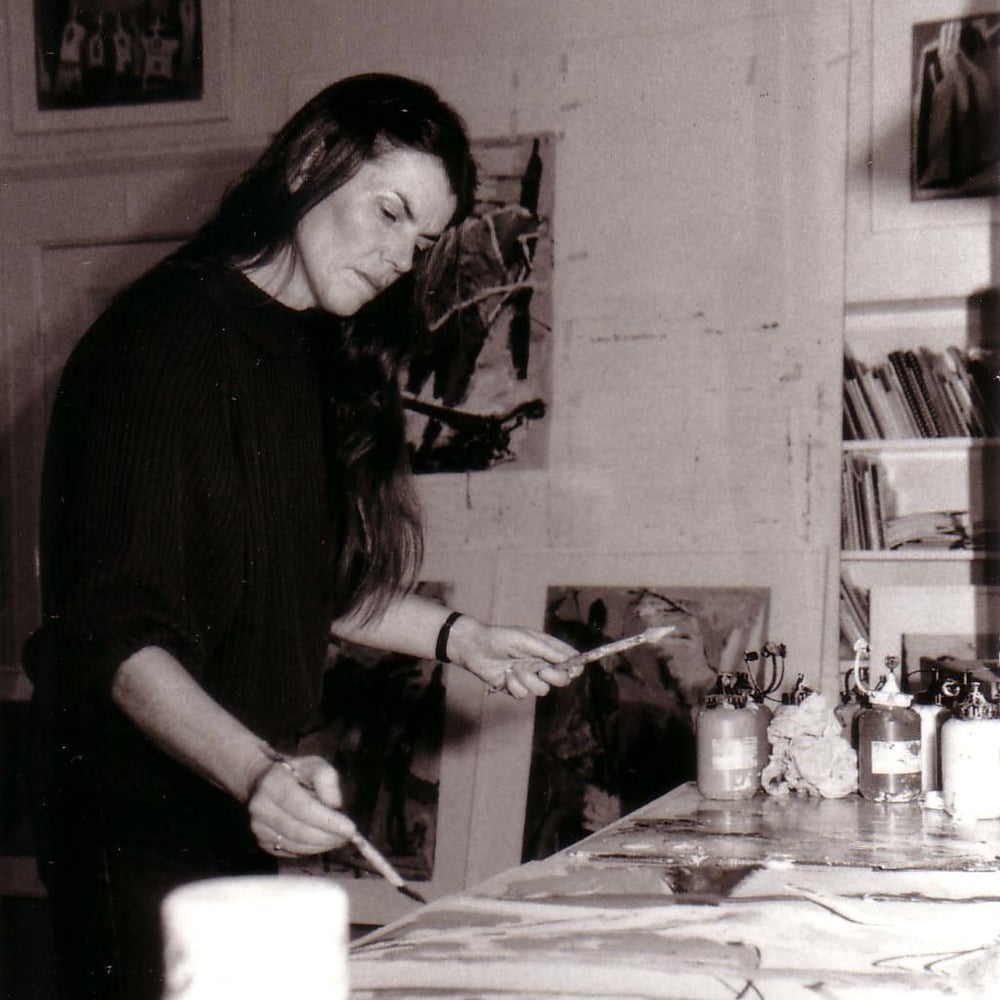

born 1946, Germany.
Art, it is commonly believed, can only be honest when it is both subjective and objective at the same time when it directly reflects the artist’s sensibilities and her doubts as to whether the gulf between desire and reality, between beauty and terror, can ever be bridged. Without any restrictions, Gina Gass lets us participate in the ambivalence of her worldview. Her search for harmony, her striving for balance, happiness, and joie de vivre, so important to us all, are most visibly expressed in her paintings.
Gina Gass uses opaque, pasty gouache colors. They allow a rapid, flowing brushstroke and create an unreal, chalky colorfulness of refracted, matte tones, which layered over one another, often allow the color of the undercoat to shimmer through. The compact surface permits “in”-sights and the viewer has a sense of having to work his way gradually through the “skins” of the painting to gain insight into its interrelationships. This structuring, the breaking up of the surface through a myriad of splatters, spots, rapid, scriptural lines, gives an idea of incessant, restless motion. It creates the illusion that, with their far-flung steps, their repertoire of graceful and capricious gestures, the two-dimensional figures create a space for themselves that they can traverse and own.
This alone is the tangible reality of the painting, the familiar relationship between figure and space in their dialog with each other. Everything else, for instance, the what and why of the artist’s intentions, is shrouded in ambiguity, in the surreal atmosphere of a walking dream. Sharp-footed, archaic idols, statuesque and mysterious, seem to grow up out of the ground, unable to free themselves from its grip. Their counterparts are light-footed harlequins and acrobats, whose gaiety is fragile because it bears within it the danger of dissolving into nothingness, into a whirl of lines and perforated splashes of color.
Interested?
Thank you! We look forward to staying in touch.
Please add the domain @hohmann.inc or the email address mail@hohmann.inc to your safe sender list or check your spam folder if you don’t hear from us.
Thank you! We will get back to you as soon as possible.
Please add the domain @hohmann.inc or the email address mail@hohmann.inc to your safe sender list or check your spam folder if you don’t hear from us.
“I used to paint with dark, shining colors…” I am leafing through one of her older catalogs. Dated 1984. “Town Wall”: a jagged line of black roofs, behind which a dark blue mass of mountains looms threateningly. Like suspended scarves, just before they fall down over the nighttime townscape and suffocate it with their blue. A three-quarters moon is the only warm spot in the background that picks up the yellow-gold – once again a rooftop – of the lower half of the picture. A picture from Provence, which she visited after her emigration. There was the sun, not shining through sheets and not obstructed by clouds. Witness to this is also “Flowers in Provence”, dominated by brilliant yellow and red; and white. Here, white is another quality of the light, not a diminution of color. Provence, says the artist, was a turning point. “Only in Provence did light enter my pictures.”
“The pictures are a part of me,” she explains. “You go through different life phases, through happy ones, through tragic ones, through sad ones, serious ones, through light, through dark…” Life, she says dictates her pictures. After all, she does believe in the possibility of translating feelings and thoughts into pictures. Painting, she concludes, doesn’t have words to express these things. That’s why she needs to rely on colors, shapes, and symbols.
-Gina Gass
Gina Gass was born in Cologne, Germany, in 1946. In 1948 her family moved to East Berlin. Gina majored in cultural studies at the Humboldt University in Berlin. Following in the footsteps of her father, a well-known documentary filmmaker, she then worked as a director’s assistant at the DEFA and as a documentarist at the Berlin Film Archives. She did not start painting until 1975. At the home of friends she met a painter, Eberhard Hückstädt, who took notice of her talent. In his studio, in Schwedt on the Oder, Gina Gass received her artistic training. In 1980 she became a member of the of the Association of Figurative Artists – in former East Germany, an unavoidable prerequisite for obtaining commissions as a painter. That is, government commissions. She created paintings for a kindergarten, a women’s clinic. In 1984 she emigrated with her family from Schwedt on the Oder to Hannover, in West Germany. For professional reasons – to finally be able to travel and visit the locales of art history – and also for political ones.
HOHMANN® is a registered trademark with the USPTO. All content on this web site, imagery and text is protected by copyright and the use of any material on this web site in full or in part without written permission is prohibited by law. There are no goods and services available from this website. It is for informational purposes only. By using this website you agree to our terms & conditions.